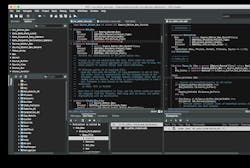MDA uses AdaCore GNAT Pro Assurance Ada software development platform for critical ISS communications subsystem
ADACORE TECH DAYS, Boston. Engineers at MDA, a business unit of Maxar Technologies, are modernizing a critical communications subsystem on the International Space Station (ISS) with the use of the GNAT Pro Assurance Ada development environment from AdaCore, with headquarters in New York and Paris. The Ku-Band communication subsystem has to work reliably over the long term; this requirement led MDA to maintain Ada as the implementation language.
The replacement Ku-Band subsystem, known as the Space to Ground Transmitter Receiver Controller (SGTRC), will interface with the existing International Space Station (ISS) Space-to-Ground Antenna, previously provided by MDA. The project includes a prototype and test unit.
“We have elected to reuse the majority of the original source code for the SGTRC replacement in its original language of Ada as a conservative design choice,” explains Bryan Tracy, software lead for the SGTRC replacement program. “Partnering with AdaCore enables us to do this with increased confidence and efficiency.”
The new SGTRC communication subsystem will support the long-term mission of the ISS and ensure the reliability and availability of high-speed data connections between the ISS, Mission Control Centers, and science laboratories on the ground.
MDA officials selected AdaCore’s GNAT Pro Assurance for the LEON3 target processor, to produce the software for a Ku-Band communication subsystem that will replace the current version. A GNAT Pro Assurance service known as sustainedbranches enables MDA software programmers to continue developing and maintaining the software over the long term using a specific version of the GNAT Pro technology, with access to code generator updates to correct critical issues.
Tools within GNAT Pro Assurance can help MDA meet project goals; among them are: the GNAT Programming Studio (GPS) tailorable Integrated Development Environment (IDE), static analysis tools for stack usage computation (gnatstack) and code metrics calculation (gnatmetric), an emulator (gnatemulator) that in effect executes LEON3 target code on the host, a testing harness generator (gnattest), and others, backed by expert support provided by the AdaCore product developers.
“Ada and AdaCore have a long and successful history in space applications in general, and with MDA in particular,” says Jamie Ayre, commercial team lead at AdaCore. “We're pleased to see that history continued with MDA's selection of GNAT Pro Assurance for the critical ISS communication subsystem.”
Founded in 1994, AdaCore supplies software development and verification tools for mission-critical, safety-critical, and security-critical systems. Four flagship products highlight the company’s offerings:
- The GNAT Pro development environment for Ada, a complete toolset for designing, implementing, and managing applications that demand high reliability and maintainability,
- The CodePeer advanced static analysis tool, an automatic Ada code reviewer and validator that can detect and eliminate errors both during development and retrospectively on existing software,
- The SPARK Pro verification environment, a toolset based on formal methods and oriented toward high-assurance systems, and
- The QGen model-based development tool suite for safety-critical control systems, providing a qualifiable and customizable code generator and static verifier for Simulink and Stateflow models, and a model-level debugger.
Customers have used AdaCore products to field and maintain a wide range of critical applications in domains such as commercial avionics, space, military systems, air traffic management/control, automotive, railway, medical devices, and financial services.
AdaCore products are open source and come with expert online support provided by the developers themselves. The company has North American headquarters in New York and European headquarters in Paris.
The go-to resource for Intelligent Aerospace technology news & information:
Covering key topics
Across all market segments
Subscribe to the free Intelligent Inbox e-newsletter
Subscribe to receive all the latest aerospace technology news & information, delivered directly to your e-mail inbox twice a week (Tuesdays and Thursdays). Sign upfor your free subscription to the Intelligent Inbox e-newsletter at http://www.intelligent-aerospace.com/subscribe.html.
Connect on social media
Keep pace with aerospace innovation and opportunities via your favorite social media channels. Connect with Intelligent Aerospace on Twitter (@IntelligentAero), LinkedIn,Google+, and Instagram.



